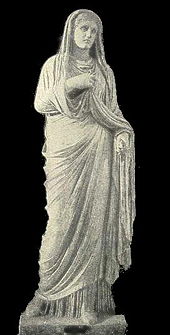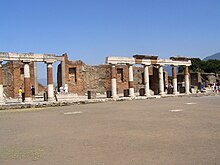
Venus is a Roman goddess, whose functions encompass love, beauty, desire, sex, fertility, prosperity, and victory. In Roman mythology, she was the ancestor of the Roman people through her son, Aeneas, who survived the fall of Troy and fled to Italy. Julius Caesar claimed her as his ancestor. Venus was central to many religious festivals, and was revered in Roman religion under numerous cult titles.
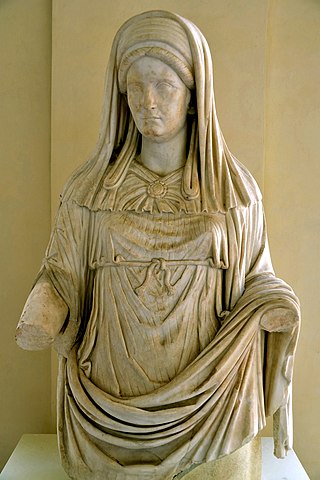
In ancient Rome, the Vestal Virgins or Vestals were priestesses of Vesta, virgin goddess of Rome's sacred hearth and its flame.

The toga, a distinctive garment of ancient Rome, was a roughly semicircular cloth, between 12 and 20 feet in length, draped over the shoulders and around the body. It was usually woven from white wool, and was worn over a tunic. In Roman historical tradition, it is said to have been the favored dress of Romulus, Rome's founder; it was also thought to have originally been worn by both sexes, and by the citizen-military. As Roman women gradually adopted the stola, the toga was recognized as formal wear for male Roman citizens. Women found guilty of adultery and women engaged in prostitution might have provided the main exceptions to this rule.

The stola was the traditional garment of Roman women, corresponding to the toga that was worn by men. It was also called vestis longa in Latin literary sources, pointing to its length.

In ancient Roman religion, Concordia is the goddess who embodies agreement in marriage and society. Her Greek equivalent is usually regarded as Harmonia, with musical harmony a metaphor for an ideal of social concord or entente in the political discourse of the Republican era. She was thus often associated with Pax ("Peace") in representing a stable society. As such, she is more closely related to the Greek concept of homonoia, which was also represented by a goddess.
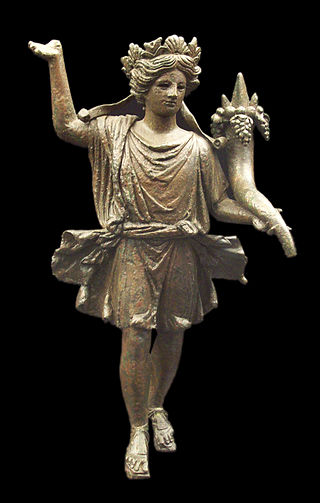
Lares were guardian deities in ancient Roman religion. Their origin is uncertain; they may have been hero-ancestors, guardians of the hearth, fields, boundaries, or fruitfulness, or an amalgam of these.

The Villa of the Mysteries is a well-preserved suburban ancient Roman villa on the outskirts of Pompeii, southern Italy. It is famous for the series of exquisite frescos in Room 5, which are usually interpreted as showing the initiation of a bride into a Greco-Roman mystery cult. These are now among the best known of the relatively rare survivals of Ancient Roman painting from the 1st century BC.

The kings of Alba Longa, or Alban kings, were a series of legendary kings of Latium, who ruled from the ancient city of Alba Longa. In the mythic tradition of ancient Rome, they fill the 400-year gap between the settlement of Aeneas in Italy and the founding of the city of Rome by Romulus. It was this line of descent to which the Julii claimed kinship. The traditional line of the Alban kings ends with Numitor, the grandfather of Romulus and Remus. One later king, Gaius Cluilius, is mentioned by Roman historians, although his relation to the original line, if any, is unknown; and after his death, a few generations after the time of Romulus, the city was destroyed by Tullus Hostilius, the third King of Rome, and its population transferred to Alba's daughter city.

Romulus was the legendary founder and first king of Rome. Various traditions attribute the establishment of many of Rome's oldest legal, political, religious, and social institutions to Romulus and his contemporaries. Although many of these traditions incorporate elements of folklore, and it is not clear to what extent a historical figure underlies the mythical Romulus, the events and institutions ascribed to him were central to the myths surrounding Rome's origins and cultural traditions.

A fullo was a Roman fuller or laundry worker, known from many inscriptions from Italy and the western half of the Roman Empire and references in Latin literature, e.g. by Plautus, Martialis and Pliny the Elder. A fullo worked in a fullery or fullonica. There is also evidence that fullones dealt with cloth straight from the loom, though this has been doubted by some modern scholars. In some large farms, fulleries were built where slaves were used to clean the cloth. In several Roman cities, the workshops of fullones, have been found. The most important examples are in Ostia and Pompeii, but fullonicae also have been found in Delos, Florence, Fréjus and near Forlì: in the Archaeological Museum of Forlì, there is an ancient relief with a fullery view. While the small workshops at Delos go back to the 1st century BC, those in Pompeii date from the 1st century AD and the establishments in Ostia and Florence were built during the reign of the Emperors Trajan and Hadrian.

Clothing in ancient Rome generally comprised a short-sleeved or sleeveless, knee-length tunic for men and boys, and a longer, usually sleeved tunic for women and girls. On formal occasions, adult male citizens could wear a woolen toga, draped over their tunic, and married citizen women wore a woolen mantle, known as a palla, over a stola, a simple, long-sleeved, voluminous garment that modestly hung to cover the feet. Clothing, footwear and accoutrements identified gender, status, rank and social class. This was especially apparent in the distinctive, privileged official dress of magistrates, priesthoods and the military.

The Temple of Isis is a Roman temple dedicated to the Egyptian goddess Isis. This small and almost intact temple was one of the first discoveries during the excavation of Pompeii in 1764. Its role as a Hellenized Egyptian temple in a Roman colony was fully confirmed with an inscription detailed by Francisco la Vega on July 20, 1765. Original paintings and sculptures can be seen at the Museo Archaeologico in Naples; the site itself remains on the Via del Tempio di Iside. In the aftermath of the temple's discovery many well-known artists and illustrators swarmed to the site.
The Chalkeia festival, the festival of Bronze-workers, was a religious festival devoted to the goddess Athena and the god Hephaestus. It was celebrated on the last day of Pyanepsion. The festival celebrated Athena and Hephaestus, in honor of both gods as patron deities of Athens, and as deities of handicrafts.

Plancia Magna was a prominent woman of Perga in the Roman province of Lycia et Pamphylia who lived in the 1st and 2nd centuries. During her life she was not only a high priestess, but a member of the decurio and a benefactress to the city, funding the restoration of the main city gates between the years AD 119 and 120.
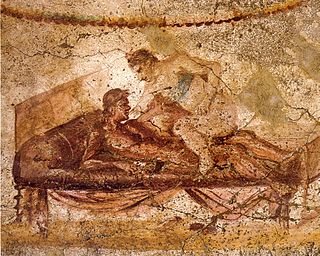
Prostitution in ancient Rome was legal and licensed. Men of any social status were free to engage prostitutes of either sex without incurring moral disapproval, as long as they demonstrated self-control and moderation in the frequency and enjoyment of sex. Brothels were part of the culture of ancient Rome, as popular places of entertainment for Roman men.
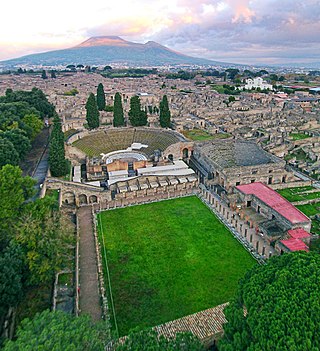
Pompeii was an ancient city located in what is now the comune of Pompei near Naples in the Campania region of Italy. Pompeii, along with Herculaneum and many villas in the surrounding area, was buried under 4 to 6 m of volcanic ash and pumice in the eruption of Mount Vesuvius in 79 AD.

The Macellum of Pompeii was located on the Forum and as the provision market of Pompeii was one of the focal points of the ancient city. The building was constructed in several phases. When the earthquake of 62 AD destroyed large parts of Pompeii, the Macellum was also damaged. Archeological excavations in the modern era have revealed a building that had still not been fully repaired by the time of the eruption of Mount Vesuvius in 79 AD.

Aurelia Paulina was a local prominent noblewoman in Anatolia who lived in the 2nd century and perhaps in the 3rd century in the Roman Empire. She was a contemporary to the rule of Roman Emperor Commodus and the Severan dynasty.

The Portico of Pompey, also known as the Great Walkway and Hall of a Hundred Pillars, was a large quadriporticus located directly behind the scaenae frons of the Theatre of Pompey. It enclosed a large and popular public garden in the ancient city of Rome. The porticus was dedicated in 55 BC. and has a history spanning hundreds of years. The colonnades contained arcades and galleries that displayed sculptures and paintings collected from years of war campaigns of its patron and builder, Gnaeus Pompeius Magnus. Over time the site became rows of shops that occupied what were the galleries and arcades. As the ground level rose from constant flooding from the Tiber River, much of the original architectural elements were re-used by shop owners to adorn their structures at higher levels. Today, many of these shops still exist and fragments of the old theatre and porticus can be seen embedded in the ancient walls of many of the buildings.

Hiereiai was the title of the female priesthood or priestesses in ancient Greek religion, being the equivalent of the male title Hierei. Ancient Greece had a number of different offices in charge of worship of gods and goddesses, and both women and men functioned as priests. While there were local variations depending on cult, the Hiereiai had many similarities across ancient Greece. Normally, their office related only to a specific sanctuary or Greek temple.
